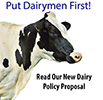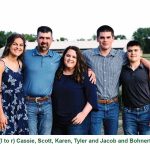Combating the economic constraints placed on family dairy farms can take various forms. One dairy may turn to high-tech solutions, while another chooses to go old school.
Either way, capable human help can be scarce. Robots provide answers for some but for centuries, people have turned to herding dogs for assistance with livestock. The same is true today.
Herding dogs bred specifically to excel at reading livestock, understanding how livestock think and move, and then providing these dogs with the right exposure and opportunity to figure out how their movement impacts stock can mold dogs into incredible partners.
“I wouldn’t return to the days of moving cows and milking alone,” noted herdsman Brendan Prendergast of Buckskin Valley Organic Dairy in south central Ohio. Milking around 100 Jersey cows is quite a bit of work for one full-time employee. But add in that the cows must be gathered from pasture in the wee hours of the morning, and Prendergast is thankful he has four-legged partners working beside him.
Prendergast’s first exposure to working dogs was on a cattle, sheep, and pecan farm in Georgia. “Beau, a Border Collie, had some training, but we figured a lot out by working together daily. He was a big help.” Leaving the South to return home to Ohio, Prendergast knew herding dogs were part of his future.
“I did lots of research on different herding breeds, the way each worked, and breeders. I first bought a pup, but that didn’t go very well. I learned it’s not as simple as just having a dog. Fortunately, I found someone nearby with years of experience who used their dogs daily and had a proven line of working dogs.”
People new to using stock dogs often get a pup without understanding all the elements needed for a successful team. First, the pup has to have the right stuff. There must be a depth of talent that comes from generations of working dogs passed down in the line. Second, the pup must be raised correctly, and third, it needs direction as it is exposed to stock.
“I have learned that good working dogs are not made or even trained. They are a result of good breeding, being raised to respect people and livestock, and then correct exposure to stock that encourages them to think and use their instincts while accepting direction and help.”
Now, six years into his journey with working dogs, Prendergast breeds and trains Border Collies and uses multiple dogs to help him with every task that involves cattle.
While his helper readies the parlor for the 5 a.m., milking, Prendergast heads out to the pasture with his two main dogs, Annie, six, and Goose, four. Sending the dogs to gather cows and navigate the dark pasture, he begins to move the one strand of electric wire to give the herd fresh grass once milking is done. Carrying on with jobs that require two hands while the dogs competently handle their task enables two jobs to be done simultaneously.

“Annie and Goose save us quite a bit of time and lots of steps each day.” Actually, it wouldn’t take much to convince Prendergast that the dogs understand conversations and can count. “I can’t tell you the number of times the dogs bring in exactly 15 cows to fill one side of the parlor, then go get the next 15.”
“Watching these Border Collies work livestock, I am always learning something; it’s a daily lesson in stockmanship,” Prendergast said. “They understand pressure and release and know when to move forward and back off. I’m not saying they are perfect, but they read livestock much better than people.”
Even when the routine changes, the dogs adapt. “We bred the cows naturally, so for several months during the spring and summer, multiple bulls are in with the cow herd,” Prendergast noted. Not wanting the bulls in the parlor, they are sorted out at each milking. Potentially this could add quite a bit of time and frustration, but the dogs lend their incredible skills here, too.
“Even when cows are in heat, the dogs somehow have the bulls sorted to the back of the herd. All I need to do is open and shut a gate,” Prendergast commented. Once milking is complete, the team pushes the herd back to pasture. “Having good dogs means one person can handle all the milking efficiently. No climbing in and out of the pit all the time,” Prendergast commented.
In addition to milking, Annie and Goose, working together or alone, assist with training heifers to calmly move through the parlor, sorting, loading and unloading trailers, feeding, and pasture rotations twice a day.
Enjoying the partnership with the dogs and often in awe of their intelligence and skill, there is a benefit to using good dogs that Prendergast wasn’t expecting. “The cattle are much calmer and easier to get along with,” he said. “Even the bulls are easier to live with.”
“An added bonus is that the dogs are essentially on call 24/7. They never complain about working and no holiday pay is needed.”










